MENUS
This page outlines the different options available to you from The SimObject Editor menus.
File
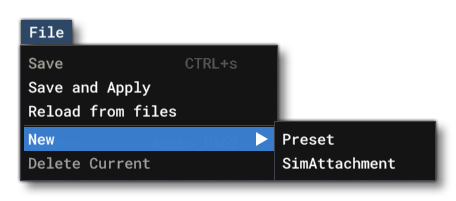 The File menu has the following options:
The File menu has the following options:
-
Save
Save any changes that have been made in the SimObject Editor to the current object source files. This will not change how the object behaves in the simulation, since it only changes the source files, not the built package (for that use the Save And Apply option, explained below).
-
Build
This option will rebuild the package from all the saved files. Note that this will overwrite any changes that have been made to the files in the editor, but that haven't been saved.
-
Create
From this sub-menu you can select to add a new Preset, Attachment, or Livery. For more information, please see here: Creating Attachments and Presets
-
Rename
This option can be used to rename the currently selected modular node.
-
Delete
This option can be used to delete the currently selected modular node.
IMPORTANT! This is a destructive operation and cannot be undone.
Edit
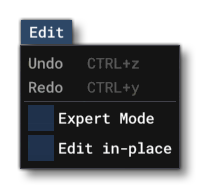
The Edit menu has the following options:
-
Undo
This option will undo the last change made to the SimObject Editor. This action can also be performed using the keyboard shortcutCtrl+ "Z". Note that this option is also available from the Undo History window.
-
Redo
This option will redo the last change that was undone to the SimObject Editor. This action can also be performed using the keyboard shortcutCtrl+ "Y". Note that this option is also available from the Undo History window.
-
Edit In Place
The default behaviour for editing files is that when you change a parameter that comes from another source, this value is overridden by the current context and a new file entry is created specific to the context. However, enabling this option means that any changes made to files from another source are edited in the source files and not in the files for the current context. For example, if you have a preset and make changes to parameters in the flight model, then those changes will (by default) only affect that preset. If you enable this option then edit the values, they will be made to the common files or the attachment that is the source for those parameters, and as such affect every other preset or attachment.
-
Highlight Potential Errors
When this option is checked, the SimObject Editor will be in "debug" mode, meaning that all parameters will be checked against an internal database, and the values they contain will also be checked to ensure they fall between the acceptable min/max, or have a correct default value, or even if they should be present based on other parameters in the file (for example, some parameters should not exist if the file or section version is not high enough). In those cases, the file, section, and parameter(s) will be highlighted in red, and there will be an exclamation mark shown, which can be moused over to get information about the error:
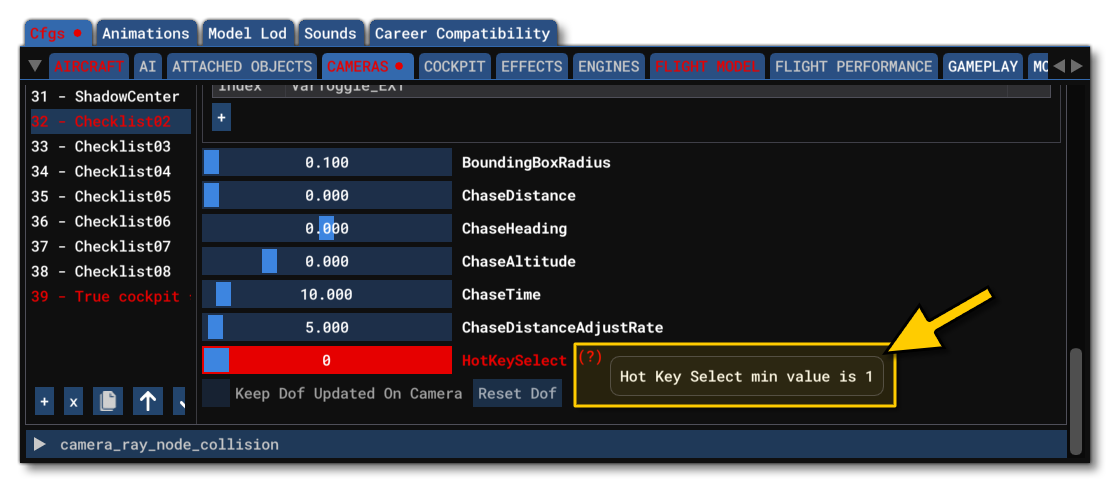
The other thing that enabling this option will do is show an error window on Save. This window will list every one of the parameters that have an issue and also include the option to automatically "fix" the issue:
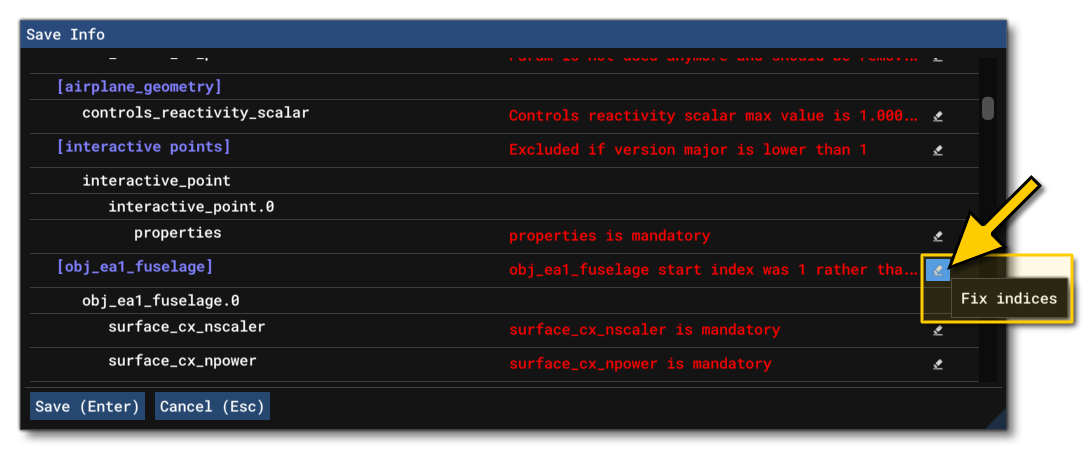 It is important to note that you should not just go through these and click "fix" for everything without understanding the issues being flagged. Some of the validation issues listed may be because of Custom Parameters, or may be because you have prepared some files for future edition but haven't yet filled in the data, etc... That's not to say you should ignore the issues listed here, but you should be sure you understand the errors as well as what the automatic fix will do before clicking the fix button. Note that you can click on the
It is important to note that you should not just go through these and click "fix" for everything without understanding the issues being flagged. Some of the validation issues listed may be because of Custom Parameters, or may be because you have prepared some files for future edition but haven't yet filled in the data, etc... That's not to say you should ignore the issues listed here, but you should be sure you understand the errors as well as what the automatic fix will do before clicking the fix button. Note that you can click on the SaveorCancelbutton at any time to save the files (whether "fixed" or not) or go back to the editor without saving. This window is also available to check parameters at any time though the CFG Validation List menu option.
View
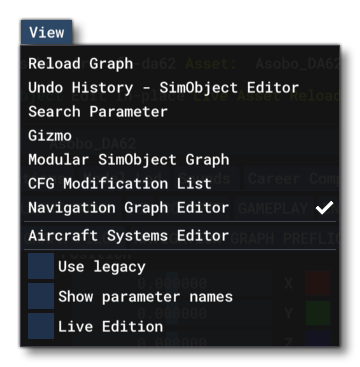 This menu is where you can open the additional SimObject Editor views (windows). Each item in the menu is explained below.
This menu is where you can open the additional SimObject Editor views (windows). Each item in the menu is explained below.
-
Undo History
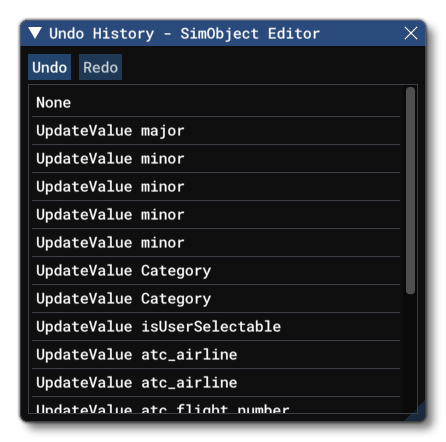 The SimObject Editor supports undo/redo functionality which can be accessed through this window, or alternatively using the keyboard shortcuts
The SimObject Editor supports undo/redo functionality which can be accessed through this window, or alternatively using the keyboard shortcuts Ctrl+ "Z" for undo, andCtrl+ "Y" for redo. From this window, however, you can select any item from the list and "reset" the editor to that state without having to go through each of the steps before or after. If you want to step through the state list, you can use the aforementioned shortcuts, or use theUndoandRedobuttons at the top.
-
Nodes
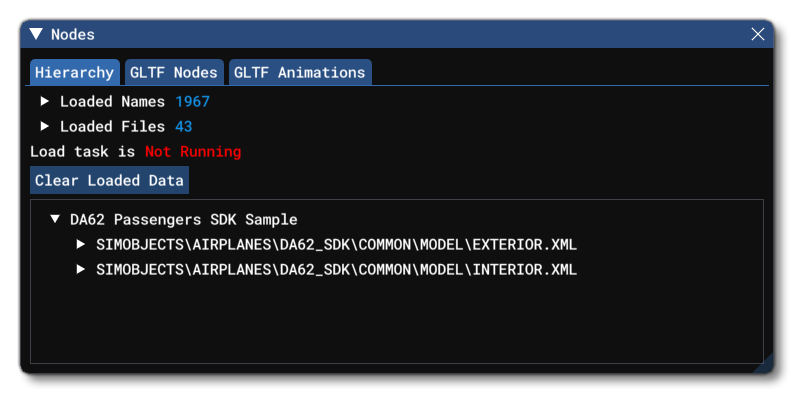 This window
This window
-
Search Parameter
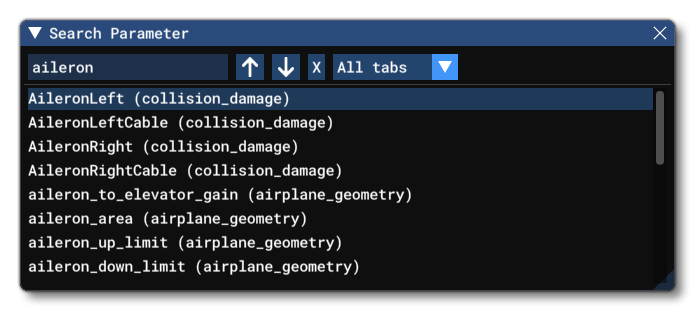
With this option you open the Search Parameter window, which is an important tool when it comes to navigating the SimObject Editor. Here you give a search term to use then press
Enterand the window will be populated with a list of parameters that contain the term you gave. You can then use the↑and↓buttons to move between the parameters in the list, and the SimObject Editor will automatically expand the sections and highlight the parameters as they are selected. You may also filter the list of parameters by changing the "All tabs" option to the tab that you want to filter for, and you can clear the filter and search term by clicking on theXbutton.
-
Curve Editor
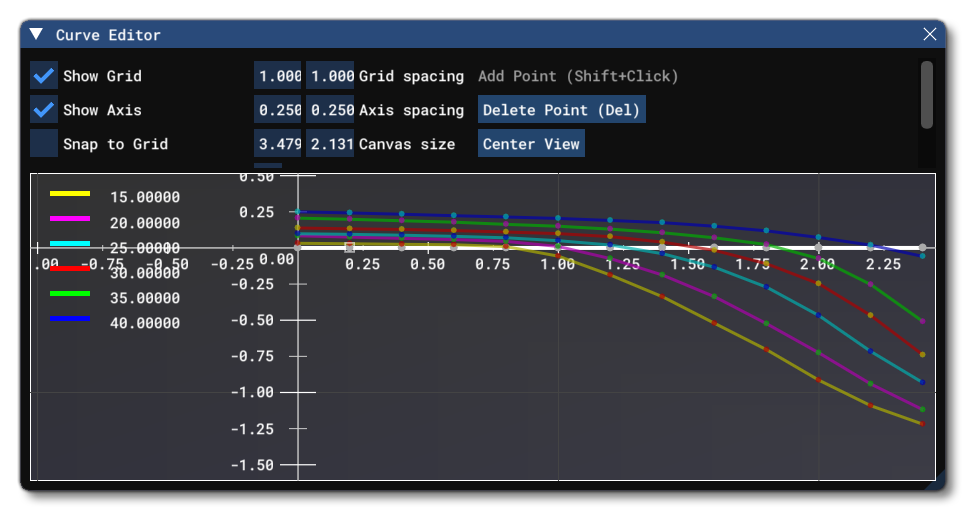
This window is used when editing any of the 1D Curve or 2D Table parameters, for example:
lift_coef_aoa_table. You can add points to the curve view canvas usingShift+ Left-Click on the canvas, and you can setup the canvas view using the options at the top:-
Show Grid - Whether or not to show the grid in the curve view.
-
Show Axis - Whether or not to show the axis in the curve view.
-
Snap To Grid - Whether points that are added should snap to the grid or not.
-
Grid Spacing - Sets the spacing (width / height) for the grid.
-
Axis Spacing - Sets the spacing (width / height) for the horizontal and vertical axis.
-
Canvas Size - Sets the size of the curve view canvas.
-
Delete Point - Deleted the currently selected point (this is also done through the keyboard shortcut
Delete). -
Center View - Centers the canvas on the (0, 0) position.
-
Reorder Points - whether or not the point should be reordered if a point is placed behind the previous one (or vice versa). It should always be checked, as it doesn't make sens mathematical to go back. It can be unchecked if the array doesn't represent interpolation tables, e.g. geometry positions, etc (not sure it exists but would rather have the option just in case)
-
Point Information - Shows the point ID as well as its position in the curve view.
-
-
Gizmo
 This option opens the Edition Gizmo. This window permits you to edit the position (and rotation and scale) of selected items within the SimObject Editor. For more information on using the tool, please see here: The Edition Gizmo
This option opens the Edition Gizmo. This window permits you to edit the position (and rotation and scale) of selected items within the SimObject Editor. For more information on using the tool, please see here: The Edition Gizmo
-
Modular SimObject Graph
This option will open the SimObject Graph window where you can visualise how the different modular nodes of the object are connected. For more information please see here: The Modular SimObject Graph
-
CFG Modification List
This will open the CFG Modification List window:
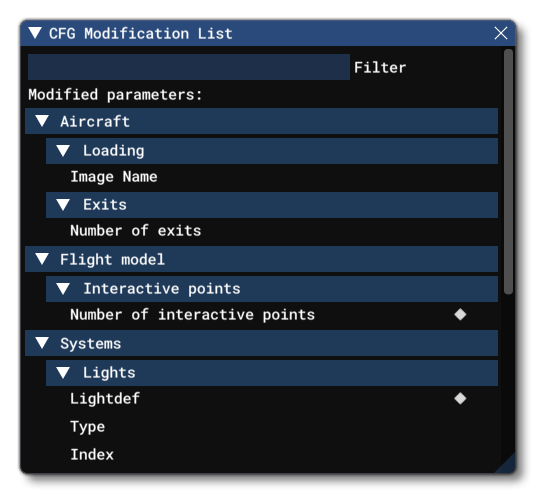 This window lists all the parameters (grouped by file and section) that have been edited for the currently selected aircraft modular node (or all nodes and files if the Edit In Place option is checked). You can filter the list using the input field at the top of the window, and if you click on any of the items in the list, the main editor will change to show that parameter. Note that if you save the project, this list will be wiped as it only tracks the changes that are currently in memory.
This window lists all the parameters (grouped by file and section) that have been edited for the currently selected aircraft modular node (or all nodes and files if the Edit In Place option is checked). You can filter the list using the input field at the top of the window, and if you click on any of the items in the list, the main editor will change to show that parameter. Note that if you save the project, this list will be wiped as it only tracks the changes that are currently in memory.
-
CFG Validation List
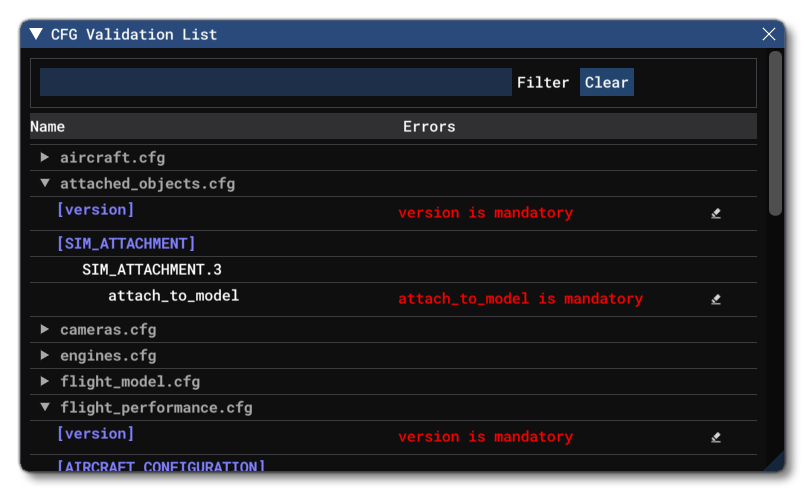
This window any potential issues that are found with the files in the currently selected modular node. If you click any of the fields, the editor will take you to the affected parameter so you can check and edit it if necessary. Some issues may be marked with a
✎and clicking this will apply a "recomended fix", which is derived from an internal database of parameter values and information, checking things like acceptable min/max values, correct default values, or even if the parameter should be present based on other parameters in the file (for example, some parameters should not exist if the file or section version is not high enough). It is important to note, however, that you should not just go through and click "fix" for everything without understanding the issues being flagged. Some of the validation issues listed may be because of Custom Parameters, or may be because you have prepared some files for future edition but haven't yet filled in the data, etc... That's not to say you should ignore the issues listed here, but you should be sure you understand the errors as well as what the automatic fix will do before clicking the fix button.
-
Navigation Graph Editor
This will open the Navigation Graph window, which is required when using the Navigation Graph. You can find further information on using this window here: The Navigation Graph.
-
Use Legacy
When this checkbox is checked, the different sections of the SimObject Editor will show those parameters that are considered part of the legacy flight model. These parameters have generally been deprecated within the current modern flight model, and so have no requirement for being set. However, they may still be required for legacy SimObjects from previous versions of Microsoft Flight Simulator 2024 that have been ported into the current version and as such this checkbox can be used to flag the object as one of these. Note that if you have already saved an object previously as a legacy object then this check box will not be automatically checked when it is loaded into the editor, and you will need to manually enable it to see the appropriate parameters in the editor (the parameter data will still have been loaded, even if it's not immediately visible).
-
Show Parameter Names
When this option is checked, the SimObject Editor will show the actual parameter names that will be saved to the corresponding CFG file instead of the more explicit common names typically shown:
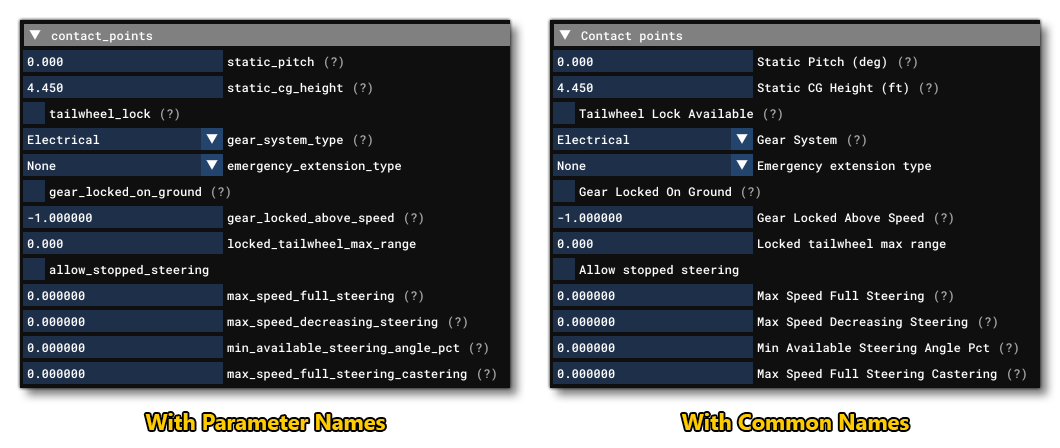
Debug

The Debug menu has the following options that can be used to debug various aspects of an aircraft. All of these options are explored in more depth from the following links:
Aircraft Data
AP (Autopilot)
Attachments
Cabin Services
Camera Blend
CFD
Complex Physics Sim
Covers And Chocks
Debug Dirt And Scratches
Drag
ECS / Pneumatic
Electrical
Engines
Flight Controls
Flight Performances
Fuel
Ground
Ground Effect
Hydraulic
Input Forces
Interactive Points
Legacy
Lights
Pitch
Sim
Sim Dimensions
Sim Info
Sim Forces
Sim Polar Power
Sim Polar VhVs
Sim Tuning
Sim Wind Tunnel
Speed
Stall
Tracking
Wear And Tear
Weight
Wheels
RMB Menu
When editing the various fields within the SimObject Editor, it may be that you make a mistake or wish to return the field to its default value. For that reason you can use the Right Mouse Button on any field to bring up the following menu:

-
Reset To Default
This option will rest the parameter to its default value. If it does not have a default value then it will leave the parameter field blank.
-
Remove From File
This option is similar to the reset to default option, only this will remove the parameter from the CFG file altogether.
Related Topics